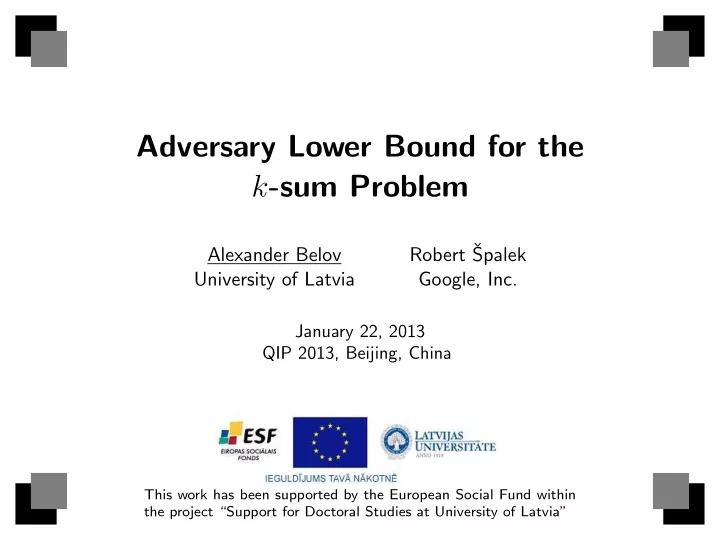

Adversary Lower Bound for the k -sum Problem Robert ˇ Alexander Belov Spalek University of Latvia Google, Inc. January 22, 2013 QIP 2013, Beijing, China This work has been supported by the European Social Fund within the project “Support for Doctoral Studies at University of Latvia”
On the Power of Learning Graphs Alexander Belov Ansis Rosmanis University of Latvia University of Waterloo Robert ˇ Spalek Google, Inc. Based on arXiv:1206.6528 and arXiv:1210.3279
Query Complexity Certificate Structures Our Results Proof Sketch Query Complexity
Problem Query Complexity Certificate Structures Our Results Proof Sketch Computational Problem The amount of resources required to solve it? Ideally: Time necessary for a quantum computer to solve it. 4 / 34
Problem Query Complexity Certificate Structures Our Results Proof Sketch Computational Problem The amount of resources required to solve it? Ideally: Time necessary for a quantum computer to solve it. Alas, we don’t know much about it. 4 / 34
Problem Query Complexity Certificate Structures Our Results Proof Sketch Computational Problem The amount of resources required to solve it? Ideally: Time necessary for a quantum computer to solve it. Simplification: Number of accesses to the input string 4 / 34
Quantum Query Complexity Query Complexity Certificate Structures Our Results Proof Sketch Function f : [ q ] n ⊇ D → { 0 , 1 } Query algorithm: calculate f ( x 1 , x 2 , . . . , x n ) , can access individual x j in one query. Quantum query complexity : number of queries the best quantum query algorithm makes on the worst input. 5 / 34
Quantum Query Complexity Query Complexity Certificate Structures Our Results Proof Sketch Function f : [ q ] n ⊇ D → { 0 , 1 } Query algorithm: calculate f ( x 1 , x 2 , . . . , x n ) , can access individual x j in one query. Quantum query complexity : number of queries the best quantum query algorithm makes on the worst input. Does this make things simpler?.. 5 / 34
Adversary Bound Query Complexity Certificate Structures Our Results Proof Sketch Quantum query complexity admits formulation as an SDP: Adversary Bound maximize � Γ � subject to � Γ ◦ ∆ j � ≤ 1 for all j ∈ [ n ] . Here: Γ is an f − 1 (1) × f − 1 (0) -matrix with real entries, and � x j � = y j ; 1 , ∆ j [ [ x, y ] ] = 0 , otherwise. 6 / 34
Query Complexity Certificate Structures Our Results Proof Sketch Certificate Structures
Simplification Query Complexity Certificate Structures Our Results Proof Sketch Simplification II: Only consider the positions of certificates inside the input string. Not the values therein. 8 / 34
Example/Motivation Query Complexity Certificate Structures Our Results Proof Sketch Quantum walk on the Johnson Graph Ambainis developed it to solve k -distinctness: Given ( x 1 , . . . , x n ) , detect whether there are k equal elements among them. Quantum walk on subsets of [ n ] . Accept if the values of variables in S ⊆ [ n ] are enough to deduce f ( x ) = 1 . � n k/ ( k +1) � Runs in O quantum queries. 9 / 34
Example/Motivation Query Complexity Certificate Structures Our Results Proof Sketch Quantum walk on the Johnson Graph Ambainis developed it to solve k -distinctness: Given ( x 1 , . . . , x n ) , detect whether there are k equal elements among them. Quantum walk on subsets of [ n ] . Accept if the values of variables in S ⊆ [ n ] are enough to deduce f ( x ) = 1 . � n k/ ( k +1) � Runs in O quantum queries. Childs and Eisenberg: The same algorithm can be used for any function with small certificates: k -distinctness, k -sum, graph collision, matrix product verification... k -sum: Given ( x 1 , . . . , x n ) ∈ [ q ] n , detect whether there are k elements whose sum is divisible by q . 9 / 34
Certificate Structure Query Complexity Certificate Structures Our Results Proof Sketch Function f : [ q ] n ⊇ D → { 0 , 1 } For x ∈ f − 1 (1) , write out: M x = { S ⊆ [ n ] | S is enough to deduce f ( x ) = 1 } . The set of all M x is a certificate structure C . (Interested in inclusion-wise minimal M x only.) 10 / 34
Certificate Structure Query Complexity Certificate Structures Our Results Proof Sketch Function f : [ q ] n ⊇ D → { 0 , 1 } For x ∈ f − 1 (1) , write out: M x = { S ⊆ [ n ] | S is enough to deduce f ( x ) = 1 } . The set of all M x is a certificate structure C . (Interested in inclusion-wise minimal M x only.) k -subset certificate structure Mutual certificate structure of k -distinctness and k -sum. 10 / 34
Recommend
More recommend